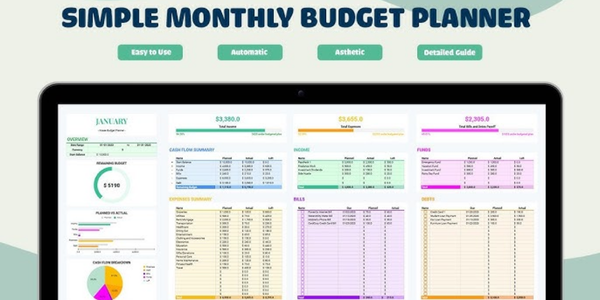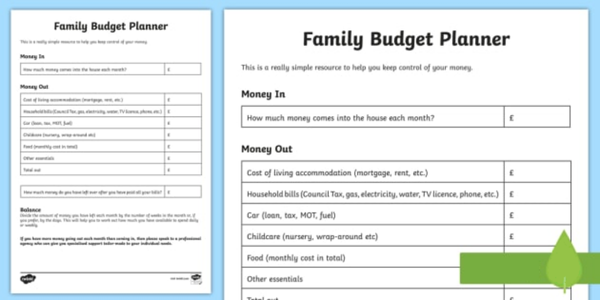Managing money doesn’t have to be scary. If you’ve ever felt overwhelmed by bills, confused by spreadsheets, or unsure where your money disappears every month, you’re not alone. Creating a budget planner for beginners can be the game-changer you need to take control of your finances.
In this guide, we’ll break down budgeting into simple, manageable steps. Whether you’re a recent graduate, new parent, or someone finally ready to tackle your finances head-on, this post will equip you with the tools and knowledge to start budgeting confidently.
Why Budgeting Matters (Especially for Beginners)
Before we dive into how to build a budget planner, let’s talk about why budgeting is so essential.
Benefits of Using a Budget Planner
-
Financial clarity: Know where every dollar goes.
-
Goal setting: Save for that dream vacation, car, or emergency fund.
-
Debt reduction: Allocate extra cash to pay down credit cards or loans.
-
Peace of mind: Eliminate money stress with better planning.
“A budget is telling your money where to go instead of wondering where it went.” – Dave Ramsey
What Is a Budget Planner?
A budget planner is a tool—digital, printable, or notebook-based—that helps you track your income, expenses, savings, and financial goals. It organizes your money flow in a way that helps you make smarter decisions.
Types of Budget Planners
-
Printable worksheets: Great for pen-and-paper fans.
-
Apps: Like Mint, YNAB (You Need a Budget), or GoodBudget.
-
Spreadsheets: Customizable using Excel or Google Sheets.
-
Physical planners: Budget-specific notebooks or journals.

Step-by-Step Guide: How to Start Budgeting for the First Time
Here’s a simple, beginner-friendly process to create your first budget planner.
Step 1: Calculate Your Monthly Income
Start with your net income—what you take home after taxes. This includes:
-
Salary or hourly wages
-
Freelance or side gig income
-
Bonuses or commissions
-
Government benefits
👉 Pro tip: If your income varies, calculate an average over 3–6 months to get a baseline.
Step 2: Track All of Your Expenses
Write down everything you spend money on in a month.
Fixed Expenses:
-
Rent or mortgage
-
Utilities
-
Car payments
-
Insurance
Variable Expenses:
-
Groceries
-
Dining out
-
Entertainment
-
Clothing
Irregular or Annual Expenses:
-
Subscriptions (e.g., Netflix, Amazon Prime)
-
Car maintenance
-
Medical costs
Use past bank statements or apps like PocketGuard to make this easier.
Step 3: Categorize and Total Your Spending
Group your expenses and compare the totals to your income.
If expenses exceed income, don’t panic. You’ll soon learn how to balance your budget.
Step 4: Choose a Budgeting Method
There’s no one-size-fits-all approach. Here are three beginner-friendly options:
1. The 50/30/20 Rule
-
50% Needs: Rent, utilities, groceries
-
30% Wants: Dining out, entertainment
-
20% Savings/Debt: Emergency fund, credit card payments
2. Zero-Based Budgeting
Assign every dollar a job. Income minus expenses should equal zero.
3. Envelope System (Cash-Based)
Use physical envelopes for each category. Once an envelope is empty—no more spending in that category!

Tools to Build the Perfect Beginner Budget Planner
Printable Budget Planner Templates
There are plenty of free and paid templates online to get you started.
Recommended sites:
Budgeting Apps for Beginners
-
Mint: Free, user-friendly, and connects to your bank.
-
YNAB: Focuses on giving every dollar a job.
-
GoodBudget: Ideal for envelope-style budgeting.
DIY Spreadsheet
Build your own in Google Sheets or Excel. Start with columns for:
-
Income
-
Fixed expenses
-
Variable expenses
-
Savings
-
Notes
Real-World Example: How Sarah Saved $5,000 in a Year
Sarah, a 26-year-old nurse, struggled to save money despite working full-time. She started with a printable budget planner and followed the 50/30/20 rule.
Here’s how she did it:
-
Cut subscription costs by canceling unused services ($50/month saved)
-
Meal prepped instead of eating out ($200/month saved)
-
Automated savings to a high-yield account ($100/month)
After a year, she saved over $5,000, paid off her credit card, and booked a vacation to Costa Rica—all thanks to consistent budgeting.
Budgeting Tips for Absolute Beginners
-
✅ Start small: Don’t aim for perfection. Just begin.
-
📆 Review weekly: Set a time each week to check in with your budget.
-
🔁 Adjust monthly: Life changes, so tweak your plan regularly.
-
💬 Involve your partner/family: Shared goals lead to shared success.
-
📊 Visualize progress: Use charts or graphs to track savings and debt.

Common Budgeting Mistakes (and How to Avoid Them)
Mistake #1: Forgetting Irregular Expenses
💡 Solution: Create a sinking fund for yearly costs like car tags, gifts, or insurance.
Mistake #2: Being Too Strict
💡 Solution: Leave room for fun so you don’t feel deprived.
Mistake #3: Not Tracking Spending
💡 Solution: Use apps or a simple notebook to log purchases.
Mistake #4: Comparing Yourself to Others
💡 Solution: Focus on your journey. Everyone starts somewhere.
How to Stay Motivated With Your Budget
Budgeting is a lifestyle, not a one-time task. To keep going:
-
Set short-term goals (e.g., pay off $500 in debt this month)
-
Celebrate milestones (buying coffee guilt-free after a savings win)
-
Join online communities like Reddit’s r/personalfinance or budgeting Facebook groups
-
Use visual trackers or printable coloring pages to mark progress
Final Thoughts: Your Financial Future Starts Now
A budget planner for beginners isn’t about restrictions—it’s about freedom. Freedom from stress, from debt, and from uncertainty. By taking these first steps, you’re investing in a future where your money works for you—not the other way around.
Start today. Choose a planner, track your spending, and set your first goal. It’s okay to stumble—it’s not okay to stop.
✅ What to Do Next
-
💬 Have you started budgeting? Comment below with your biggest challenge!
-
📚 Explore more: Check out our guide to best budgeting apps of the year or how to build an emergency fund.
-
📩 Subscribe to our newsletter for weekly money tips and free templates.


